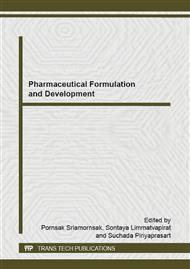p.199
p.203
p.207
p.211
p.215
p.219
p.223
p.227
p.231
In Vitro Comparison of Probiotic Properties of Lactobacillus fermentum SK54 Isolated from New Born Baby with Lactobacillus rhamnosus GG ATCC 53103
Abstract:
A lactobacillus strain isolated from the feces of a healthy baby was identified as Lactobacillus fermentum SK54. The probiotic properties of this strain including antimicrobial activity, survival in acid, bile, simulated gastric fluid [SGF] and simulated intestinal fluid [SIF], antibiotic susceptibility and adherence to Caco-2 cells were examined and compared them with a well known commercial probiotic strain Lactobacillus rhamnosus GG ATCC 53103 isolated from human intestine. L. fermentum SK54 and L. rhamnosus GG showed inhibitory properties toward gastrointestinal pathogens i.e., Staphylococcus aureus, Escherichia coli, Pseudomonas aeruginosa, Salmonella Typhimurium, and Shigella sonnei by cylinder-plate assay. The inhibitory substances from L. fermentum SK54 composed of acid substances naturally produced by lactobacilli and high molecular weight proteinaceous compound [MW > 3.5 kDa] which sensitive to proteolytic enzymes, pH stability [pH 2.0-5.0] and heat stability [60, 80, 100°C for 10 min and 121°C for15 min]. L. rhamnosus GG produced only acid inhibitory substances. Both strains survived well at low pH [pH 2.0-4.0], bile salts [0.1-0.3% w/v], SGF and SIF. They also had the same 14 tested antibiotic sensitivity pattern and expressed high adherence to Caco-2 cells. This study provides a rationale to support L. fermentum SK54 as a potential probiotic to prevent or act as a therapeutic agent against pathogenic strains.
Info:
Periodical:
Pages:
215-218
Citation:
Online since:
December 2014
Authors:
Price:
Сopyright:
© 2015 Trans Tech Publications Ltd. All Rights Reserved
Share:
Citation:


